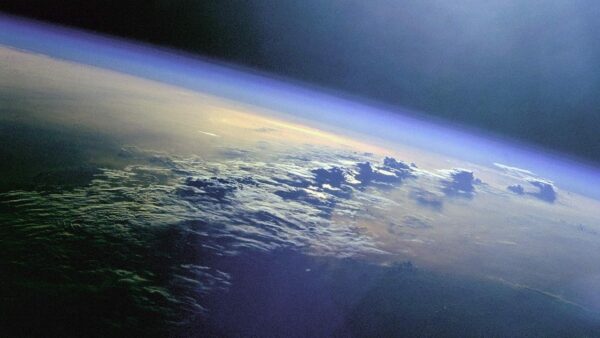The solar system consists of our local star, the Sun, and everything that is bound to it by gravity. This includes 8 planets; at least 5 dwarf planets such as Pluto; dozens of moons; and millions of asteroids, comets, and meteoroids.
Our planetary system is named the solar system because the name of our star, “Sun,” is from the Latin word “Sol.” Therefore, anything relating to the Sun we call “solar.”
Planets Of The Solar System
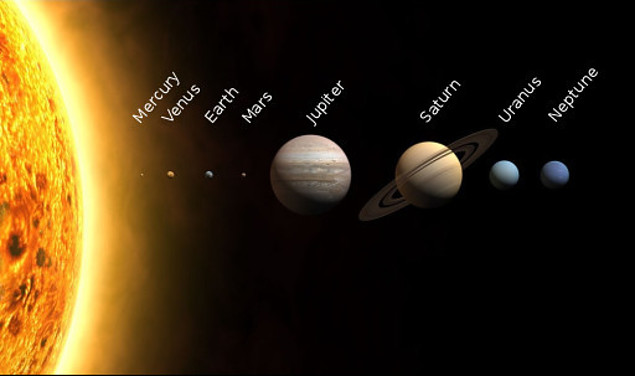
- How Did The Solar System Form?
- What Is The Solar System’s Composition?
- Other Than On Earth, Is There Life In The Solar System?
- Where In Our Galaxy Is The Solar System?
- Are There More Planetary Systems Like Ours?
How Did The Solar System Form?
The solar system formed from a dense cloud of interstellar gas and dust around 4.5 billion years ago.
At some point an event is thought to have triggered the collapse of the cloud, possibly the shock wave of a nearby exploding star. When this enormous dust cloud collapsed it started to spin, and at the centre gravity pulled more material in.
This created a protostar which in time formed into the Sun.
Dust particles further out in the disk started to clump together into bigger and bigger objects. Some became so huge that their gravity shaped them into spheres and they became planets and moons.
What was left remaining in the early solar system was smaller material that didn’t quite clump together to a size which meant they became spherical. These smaller leftover pieces became meteoroids, asteroids, comets and small irregular moons.
What Is The Solar System’s Composition?
PLANETS
The largest components of the solar system are the eight planets which orbit the Sun. The way the planets are arranged in order from the Sun is due to the way the solar system formed.
The closest planets to the Sun – Mercury, Venus, Earth and Mars (called the terrestrial planets) have a compact rocky surface. This enabled them to withstand the heat of our newly formed star within the developing solar system.
The approximate relative sizes of the terrestrial planets.
(Mercury, Venus, Earth and Mars)
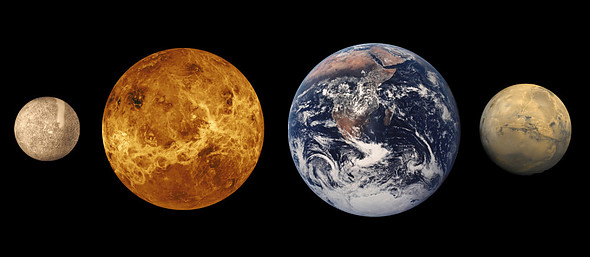
Mercury
The closest planet to the Sun, at 35.98 million miles (57.91 million km) away, is Mercury. The smallest planet in the solar system, it only takes 88 days for a full orbit of the Sun. It has a very thin atmosphere and a surface covered in craters.
Venus
Venus is the next planet out from the Sun and is 67.2 million miles (108.2 million km) away from our home star. It takes 225 days to orbit the sun and is a similar size to Earth, having a radius of 6,052 km.
Although not the closest planet to the Sun, it is the hottest in the solar system. The temperature at the surface is an incredible 467 °C,( 872 °F). This is largely due to its thick toxic atmosphere of carbon dioxide which traps heat.
Coupled with thick yellowish clouds of sulfuric acid covering the planet, and crushing pressure at the surface, Venus is not a pleasant place!
Earth
The third planet from the Sun is the largest of the terrestrial planets, our home planet Earth. At 93 million miles (150 million km) away, light from the Sun takes 8 minutes to reach our planet.
The only planet known to harbour life, over 70% of the Earths surface is covered in water.
Mars
The furthest out of the terrestrial planets, Mars is the fourth planet from the Sun, and the second smallest in the solar system. It is 141.6 million miles (227.9 million km) from the Sun, and takes 687 days to orbit our home star.
Mars has a thin atmosphere of which only around 1% is oxygen and therefore unbreathable. Iron Oxide on the surface gives this planet a striking reddish appearance in the night sky, hence why Mars is often referred to as the “red planet”.
As the young solar system formed the huge amounts of gas and ice settled in the outer regions where gravity pulled these materials together. This is where we find gas giants Jupiter and Saturn, and the ice giants Uranus and Neptune.
These four planets are much larger than their rocky terrestrial neighbours. This is because all four planets are made up mostly of hydrogen gas. A gas occupies much more space the solid material and so these planets have developed into a much larger size.
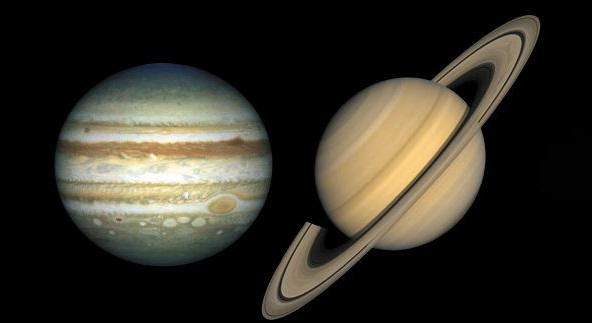
Jupiter and Saturn – The ‘Gas Giant’ Planets
Jupiter
Jupiter is the fifth planet from the Sun and is the largest in the solar system. It is around 11 times wider than Earth, and has a mass more than two and a half times that of all the other seven planets combined.
This gas giant lacks a rocky surface and if it has a solid inner core at all, its thought to be around the size of Earth.
At a distance of 483.45 million miles (778.5 million km) from the Sun, this planet takes about 12 Earth years to complete one orbit.
Jupiters appearance is due to bands of different gases which run across the planets atmosphere, The ‘great red spot‘ is another noticeable feature which is a spinning storm that has been observed for at least 200 years.
This huge storm is around two and a half times the size of Earth, with winds estimated to be around 270 mph!
Saturn
The sixth planet from the Sun is Saturn, which is close to one billion miles away (0.89 billion miles or 1.43 billion kilometres). It takes Saturn 29 Earth years to complete one orbit of the Sun.
Saturn is the second-largest planet in the Solar System after Jupiter, and has a diameter almost ten times that of Earth. Like Jupiter, planet Saturn has an atmosphere predominantly of Hydrogen.
A dramatic feature of Saturn is the extensive ring system which orbits the planet. These series of rings are made almost entirely of water ice ranging from small particles to several metres in size.
The two ‘ice giant’ planets are so called because, although like Jupiter and Saturn their atmospheres mostly consist of Hydrogen and Helium, their interiors are primarily composed of ices and rock. They are known as ‘ice planets’ to emphasize this distinction.
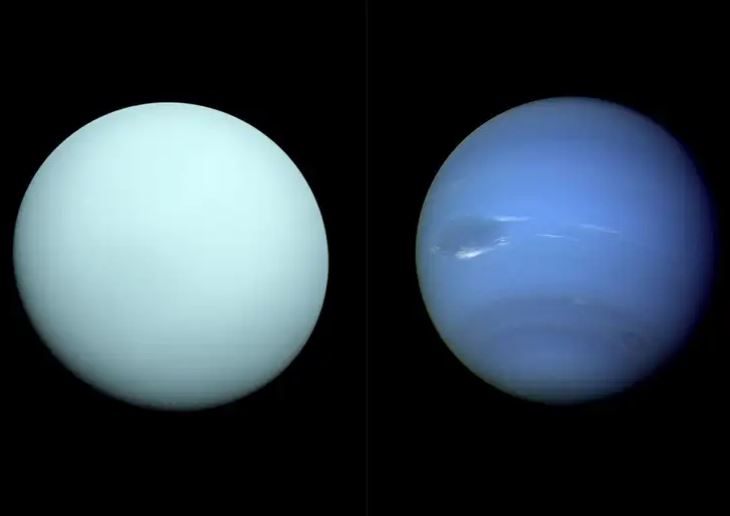
Uranus and Neptune – The ‘Ice Giant’ Planets
Uranus
Uranus, the seventh planet from the Sun has an atmosphere which apart from Hydrogen and Helium, contains water, methane and ammonia fluids. It’s the amounts of methane in the atmosphere which gives this planet a pale blueish colour.
Uranus orbits our home star once every 84 years and is an average of around 2 billion miles (3 billion km) away from the Sun.

Size Comparison Of Earth And Uranus
Neptune
Of all the solar systems planets, Neptune is the eighth and furthest from the Sun. It is so far away that it takes an amazing 165 years to orbit the Sun at an average distance of 2.8 billion miles (4.5 billion km).
A relatively recent discovery has revealed a storm in the atmosphere of Neptune similar to that on Jupiter. Named the ‘great dark spot’ this storm is driven by the strongest winds in the solar system at 1,300 mph! (2,100 km/h).
Like Uranus, Neptune has a blueish colour through amounts of methane in the atmosphere.
MOONS
Moons (also called natural satellites) are solid bodies which orbit a host planet, and there are hundreds of them in the solar system. Most planetary moons formed in the early solar system from gas and dust that circulated the newly formed planets.
Moons in the solar system are a variety of shapes and sizes and different types.
There are at least two moons with subsurface oceans. There are volcanic moons, and one even has its own atmosphere and lakes of ethane and methane on the surface.
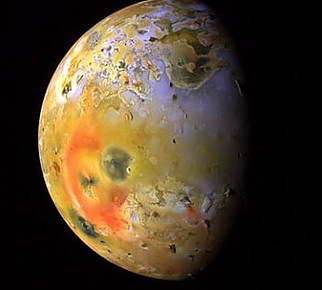
Jupiter’s moon Io – The Most Volcanically Active Body In The Solar System
The terrestrial (rocky) planets of the inner solar system have far fewer moons than the gas giants Jupiter and Saturn, and the ice giants Uranus and Neptune. These giant planets were able to capture many smaller objects with their large gravitational fields.
Each planet has the following number of moons
- Mercury 0
- Venus 0
- Earth 1
- Mars 2
- Jupiter 79 (53 confirmed, 26 provisional)
- Saturn 82 (53 confirmed, 29 provisional)
- Uranus 27
- Neptune 14
(Some moons are classed as provisional until their discoveries are confirmed by additional observations.)
THE ASTEROID BELT
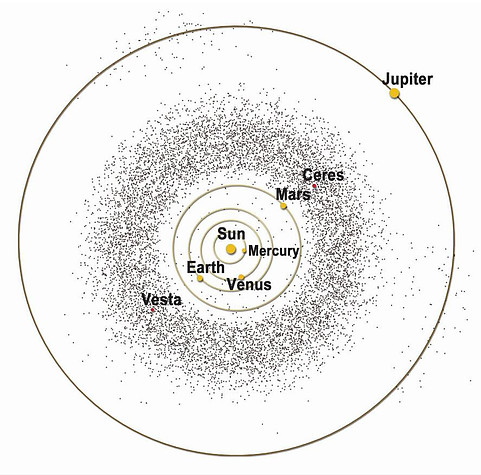
Credit : NASA/McREL
The asteroid belt is a region in the solar system, mostly between the orbits of Mars and Jupiter, which is composed of remnants of rock and debris from the creation of the solar system. These range in size from a small rock to what is classed as a dwarf planet.
The width of the asteroid belt is approximately 1 AU (Astronomical Unit). An astronomical unit is measured as the distance between the Earth and the Sun (93 million miles).
The first (and also the largest) object discovered in the asteroid belt was named Ceres. Called an asteroid for many years, Ceres is so much bigger than other objects in the asteroid belt that scientists classified it as a dwarf planet.
Whereas the asteroid belt contains irregular shaped objects, Ceres is large enough for gravity to mould its shape into a sphere.
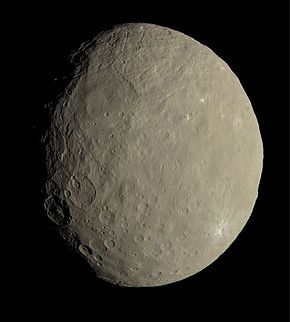
Ceres – 939km wide.
Vesta is the next biggest object in the asteroid belt. About half the size of Ceres, it has an irregular shape which is more typical of asteroid belt objects.
Vesta is the brightest asteroid in the night sky due to its light-coloured surface reflecting more of the suns light. At its brightest Vesta is just about visible to the naked eye.
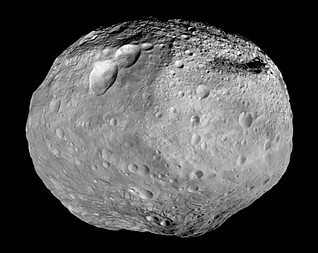
Vesta – 525km wide.
The Asteroid belt is estimated to contain between 1.1 and 1.9 million asteroids larger than a kilometer in diameter, and millions of smaller ones.
Even so, a common misconception is that the Asteroid belt is densely packed. In fact, its been calculated that there is an average distance of around 600,000 miles between objects.
THE KUIPER BELT
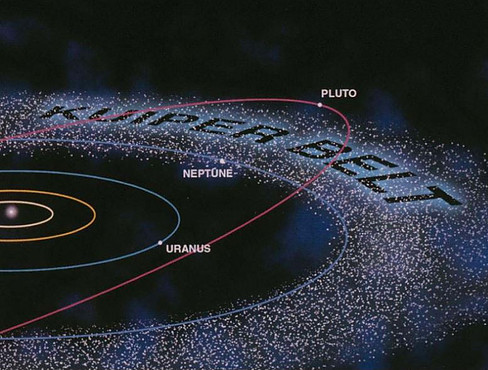
The Kuiper belt extends from the orbit of Neptune, around 30 AU from the Sun, to approximately 50 AU. This makes it far larger than the asteroid belt. at about 20 times as wide.
Like the asteroid belt, it consists mainly of remnants from when the solar system was formed, Unlike the rocky objects of the Asteroid belt, these objects are composed mostly of different ‘ices’ such as water, methane and ammonia.
The Kuiper belt is thought to be the source of most of the observed short-period comets, (Comets which orbit the Sun in less than 200 years). It has also been estimated that there are hundreds of thousands of objects in the Kuiper Belt region that are at least 100km wide or larger.
The kuiper belt is where four of the five objects known as dwarf planets are found. The first object discovered in the kuiper belt is the largest and most famous. Once regarded as the 9th planet from the Sun, Pluto has now been classified as a dwarf planet.
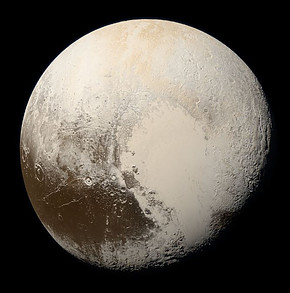
The Dwarf Planet – Pluto
THE OORT CLOUD
Little is known about the immense, roughly spherical cloud of small icy bodies called the Oort cloud. The objects are too small, faint and far away to be directly imaged. In fact, we know so little about it that its very existence at the edges of the solar system is theoretical.
The Oort clouds inner edge is thought to be 1,000 to 2,000 AU from the sun. This vast spherical structure which envelops the rest of the solar system is believed to stretch to 100,000 AU away, which is halfway to the Suns closest star!
It is thought that the Oort cloud could contain billions of icy objects a big as a kilometre wide
Most of what we know of the mysterious Oort cloud is from long-period comets (Comets which take more than 200 years to orbit the Sun). Although theoretical, the Oort cloud remains the most widely-accepted explanation for the origin of long-period comets.
Other Than On Earth, Is There Life In The Solar System?
Of all the variety of planets and moons in the solar system only our home planet, Earth, is known to host life. That’s not to say that there aren’t a few tantalizing prospects for primitive life.
Mars
From what we know of planet Mars we can say with some confidence that between 3 to 4 billion years ago the climate was similar to Earths in that it had liquid water on the surface.
The recent discovery of a lake beneath the southern polar ice cap, and the detection of salty water in gullies and craters makes Mars a very interesting candidate for life.

Traces of salty water have been detected on Mars, such as this impact crater with dark streaks along its inner edge.
Enceladus
Enceladus at around 500km (310 miles) in diameter is the sixth-largest moon of Saturn. It’s also by far the brightest.
The reason for this became apparent when it was discovered that a large area of the surface was remarkably smooth and almost entirely made up of water ice. This makes Enceladus the most reflective body in the solar system.
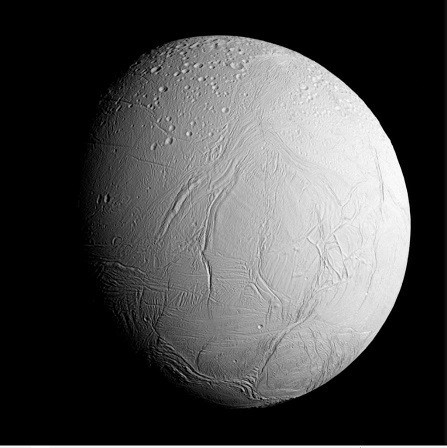
Enceladus
In 1981 the Voyager spacecraft flew past Enceladus and revealed its surface to be complex geologically. It was the Cassini mission though in 2005 which really had the scientists excited.
Sensors aboard the Cassini spacecraft revealed that this tiny moon hides a global ocean of liquid salty water beneath its crust. Photos from Cassini also revealed a most unexpected event.
Jets of water vapour and ice are continuously erupting from the hidden ocean to a height of as much as 2,500 miles from the surface.
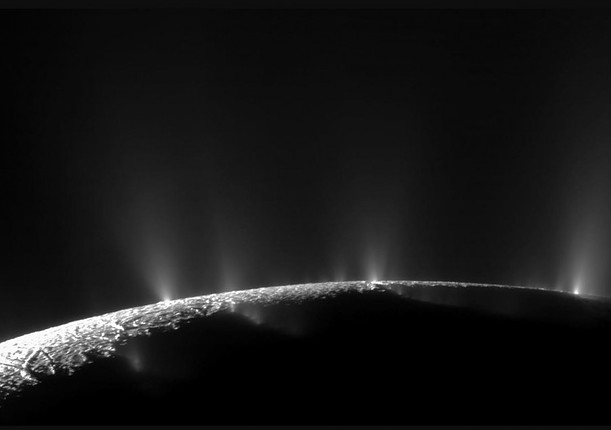
Plumes erupting from the surface of Enceladus
These plumes of water and simple organic chemicals originate from hot areas of four main ridges. Known as ‘tiger stripes’, they appear to be tectonic fractures surrounded by fields of ice boulders.
Detection of hydrocarbons in the plume point to the possibility of hydrothermal vents deep beneath Enceladus’ icy shell. These could be similar to the hydro thermal vents that dot the ocean floor here on Earth.
Titan
Titan is Saturn’s biggest moon, and at 5,150 miles diameter (8288 km) it is the second largest in the solar system. It’s even bigger than the planet Mercury and is almost the size of Mars.
This complex moon has many interesting features. It is the only moon in the solar system with a dense hazy atmosphere and the only world other than Earth with lakes on its surface.
The lakes on Titan though are far different than those on Earth. They have been found to be made of liquid Methane and Ethane!

Titan
Measurements made by the Cassini spacecraft also revealed an underground ocean of liquid water. Even though these measurements strongly suggest this ocean could be as much as 50 miles under the icy surface, this could be of great significance.
Europa
Europa is the sixth closest moon to Jupiter, and also the sixth largest moon in the solar system. At 1940 miles diameter (3122 km), Europa is slightly smaller than Earths moon.
Many scientists believe that Europa has the most promising environment in the solar system for some sort of life to form beyond our planet.

Europa
While the surface of Europa is covered in ice that, because of intense cold is as hard as rock, the interior is different. Scientists are almost certain that beneath the icy surface of Europa is an ocean maintained by tidal flexing.
Tidal flexing is a product of Jupiter’s huge gravity during Europa’s orbit, and this gently heats the moon from the core maintaining the ocean in a liquid state.
Scientists think Europa’s ice shell is 10 to 15 miles thick, floating on an ocean 40 to 100 miles deep. So while Europa is only one-fourth the diameter of Earth, it is thought to contain around twice as much water as Earth’s oceans combined.
A vast underground ocean, coupled with recent data suggesting water plume activity on the surface, makes Europa arguably the most promising place to look for life beyond Earth.
Where In Our Galaxy Is The Solar System?
Our home galaxy, Milky Way, is a spiral structure dominated by two major arms wrapping off the end of a central band of stars.These major arms consist of the highest densities of stars.
There are also several minor arms which are mostly filled with gas and pockets of star-forming activity. Our solar system lies near a minor arm some 26,500 light years from the centre of the Milky Way.
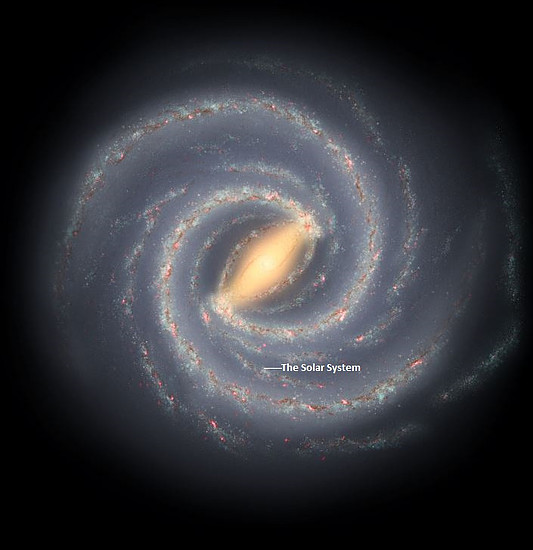
Position of the Solar System in the Milky Way
Are There More Planetary Systems Like Ours?
So far, scientists have discovered in excess of 5000 exoplanets (a planet outside of the solar system) and these have proven to be fascinating and amazingly diverse.
These include small rocky worlds like Earth, gas giants many times larger than Jupiter, and even ‘hot Jupiters’ in very close orbits around their stars.
Within our galaxy, milky way, there are estimated to be between 100 to 400 billion stars. It is thought that, on average, each star has at least one planet orbiting it. The latest data estimates the number of galaxies in the universe at a mind blowing 200 billion.
Which means that in all probability there are billions of systems like ours in the universe, with planets orbiting their own host star.
